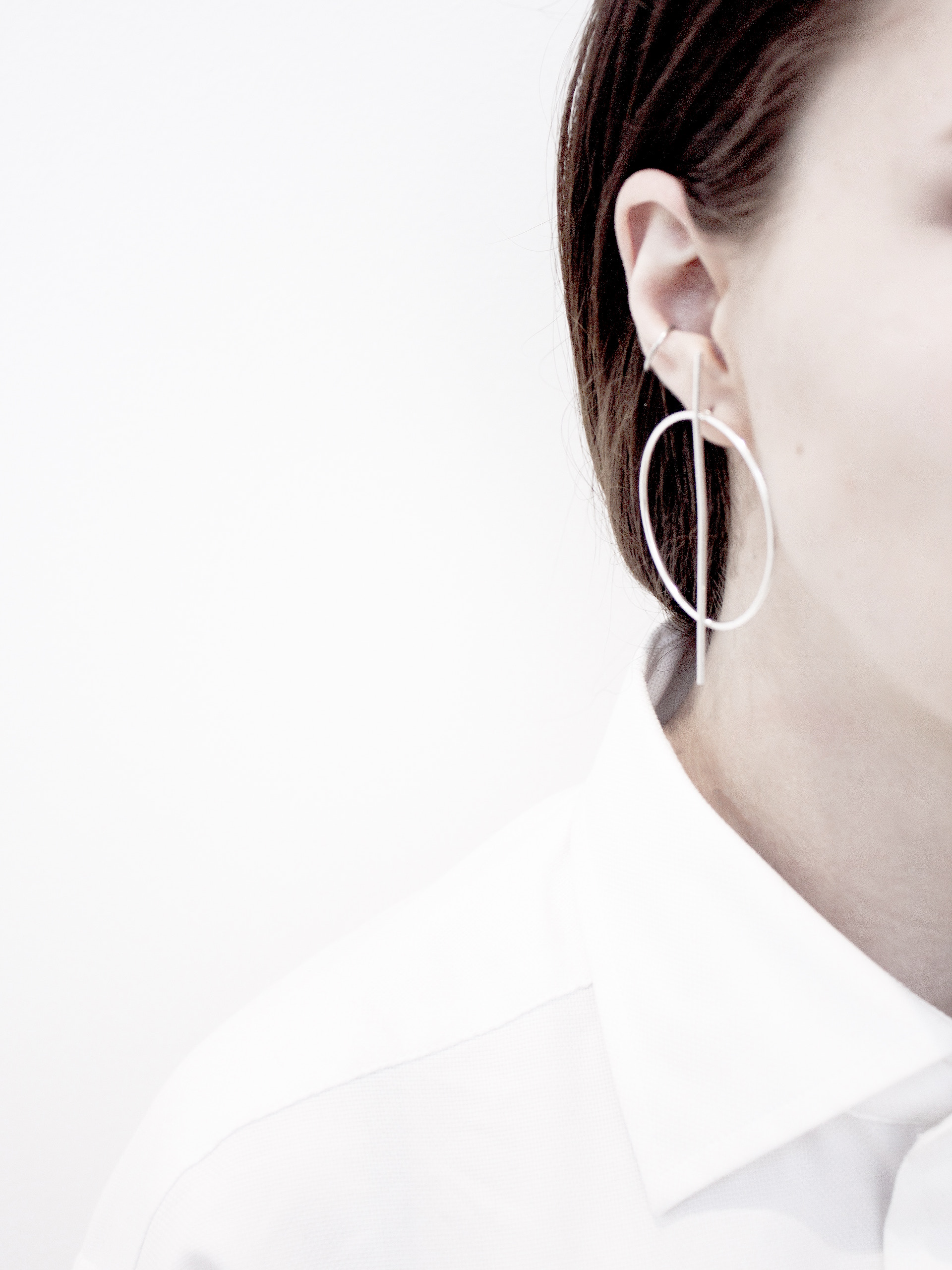
Acupuncture is an ancient form of healing method in Traditional Chinese Medicine (TCM) that involves inserting needles into acupoints, specific points on the body’s surface.
Scary as it may sound or look to some people, its effects are undeniably magical and fast but yet, scientific. In TCM terminology, acupuncture heals by stimulating acupoints to clear qi and blood stagnations in the meridians and at the same time, balance the yin and yang of the body.
Scientifically speaking, acupuncture relieves pain, reduces inflammation, and restores homeostasis. In fact all disease involves a disturbance of homeostasis, and nearly all disease involves some degree of pain and inflammation. Therefore, one can say that acupuncture has the ability to treat all disease and ailments faster and without the side effects of medication. Acupuncture can be administered on a long-term basis for health maintenance and disease prevention.
Apart from needling, there are many other ways that can bring about stimulation of acupoints, such as using the thumb or index finger to press and massage the points or perform striking actions on the points, otherwise known as acupressure. Modern medical studies have confirmed that such stimulations of acupoints can promote the body’s secretion of endorphins which is a natural tranquilizer in the human body, bringing about great sedative and relaxation effects. Regular acupressure self-massage can effectively promote blood circulation and slow down the aging of cells, hence invigorating the body at the same time.
Today white-collar workers face serious health issues due to spending long hours working in front of computers and experiencing immense daily work stress, making them more susceptible to occupational ailments such as cervical spondylosis, visual fatigue, chronic neck, back, and wrist pains. In this article, we share four simple and effective TCM acupressure self-massage as a form of prevention of these occupational ailments.
4 Acupressure Self-Massage To Try
Hitting or Massaging Hou Xi Acupoint
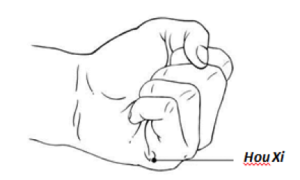
Location of Acupoint Make a loose fist and find the point on the ulnar side of the palm at the end of the transverse crease, close to the fifth joint between the palm and small finger. (see diagram)
Technique With both palms facing up, hit the ulnar sides of the palms against each other for 50 to 100 times. Otherwise, with one palm facing the chest, massage the Hou Xi acupoint with the thumb of the other hand for 2-3 minutes. Switch and repeat the massage for the other hand.
Benefits People who spend long hours writing or typing on computers will often find themselves having sore shoulders and necks, which may ultimately result in chronic neck pain or strains and cervical spondylosis if left unaddressed. Hou Xi acupoint is found along the meridian that links the neck, shoulder, and fingers. Hitting Hou Xi acupoint can help to relax and relieve soreness in the neck muscles. Frequent stimulation of this acupoint can help prevent acute neck sprain/strain, growth of cervical bone spurs and cervical degeneration.
Massaging Cheng Qi Acupoint
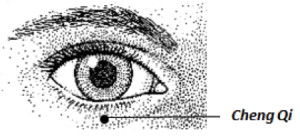
Location of Acupoint With eyes looking straight ahead, the acupoint is vertically under the pupil, below the eyeball and above the lower border of the orbit.
Technique Use the index fingers of both hands to lightly massage the acupoints near both eyes in a clockwise or anticlockwise direction simultaneously for 10 minutes after working at the computer for 1 to 2 hours.
Benefits Daily long hours of looking at the computer screen can result in the overuse of the eyes and can expose one to heightened light stimulation and radiation. This can in turn lead to health issues such as blurred vision, dry eyes, and dizziness. Through frequent massage of Cheng Qi acupoint, qi and blood nourishment to the eyes can be increased, bringing relief to tired eyes, the chances of eye diseases can be reduced, and eyesight can be improved over time.
Hitting or Massaging Lao Gong Acupoint
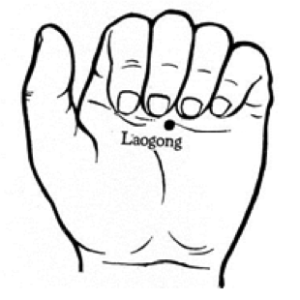
Location of Acupoint At the centre of the palm, between the 2nd and 3rd metacarpal bones, and in the part touching the tip of the middle finger when a fist is made.
Technique With one hand making a fist, the acupoint which is located at the centre of the palm is hit with the fisted hand at an intensity where the area of the acupoint feels lightly sore. Repeat for 36 times. Otherwise, with one palm facing up, massage the Lao Gong acupoint with the thumb of the other hand for 2-3 minutes. Switch and repeat the massage for the other hand.
Benefits The pericardium is the outer covering of the heart. In TCM, it is recorded in classics that the pericardium “takes on illnesses and ailments on behalf of the heart”, meaning that not only is it a physical protective covering for the heart, it is also more susceptible to illness and conditions related to the heart such as stress, anxiety, depression, and fatigue.
Therefore, during times of negative emotions developed from work, hitting or massaging Lao Gong acupoint, located on the Pericardium Meridian, can relieve tension and fatigue. Furthermore, frequent stimulation of this acupoint can have the additional benefits of soothing the nerves, promoting better sleep, reducing stress, and relieving tension of the hand muscles.
Massaging the Ear Acupoints
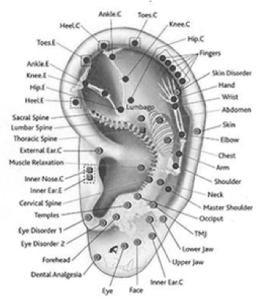
Location of Acupoints All over the ears.
Technique Using both hands, lightly massage both ears in a clockwise or anticlockwise direction for 36 times simultaneously.
Benefits The ear contains over 120 acupoints that correspond to various parts of the body. In fact, when seen as a whole, the areas represented by different ear acupoints is said to be an illustration of an inverted near-term fetus projected onto the ear.
In TCM, it is mentioned that all major meridians pass through the ear, making massaging of the ears effective in treating a variety of ailments throughout the body. Therefore, for people who lack exercise and have poor circulation, massaging the ear acupoints can stimulate most of the meridians and quickly increase body circulation. Frequent massaging of the ear acupoints can even improve the general state of health.
Lim Xiang Jun is a licensed TCM and Acupuncture practitioner based in Singapore and is currently a PhD post graduate in Acupuncture and Tuina in Beijing University of Chinese Medicine. With a Bachelor Degree in Biomedical Science from Nangyan Technological University of Singapore and a Bachelor Degree in Traditional Chinese Medicine and a Master Degree in Acupunture and Tuina from Beijing University of Chinese Medicine, along with being a Yoga Alliance RYT 200 Certified Yoga Teacher and Reiki Level 1 and 2, Xiang Jung holds a unique integration of traditional and modern knowledge for her practice and in the therapeutic information she shares with her patients.
Having spent more than six years in Beijing has also given Xiang Jun time to deeply explore the Chinese culture and develop the wisdom to apply the philosophies behind a different artistry to her clinical TCM practice. Xiang Jun has trained with masters from the academic field and those who live incognito. Her TCM and acupuncture treatments bring surprisingly immediate relief to many painful conditions.
Besides pain management, Xiang Jun also specializes in treating conditions related to gynaecology, paediatric, and stroke sequelae.

